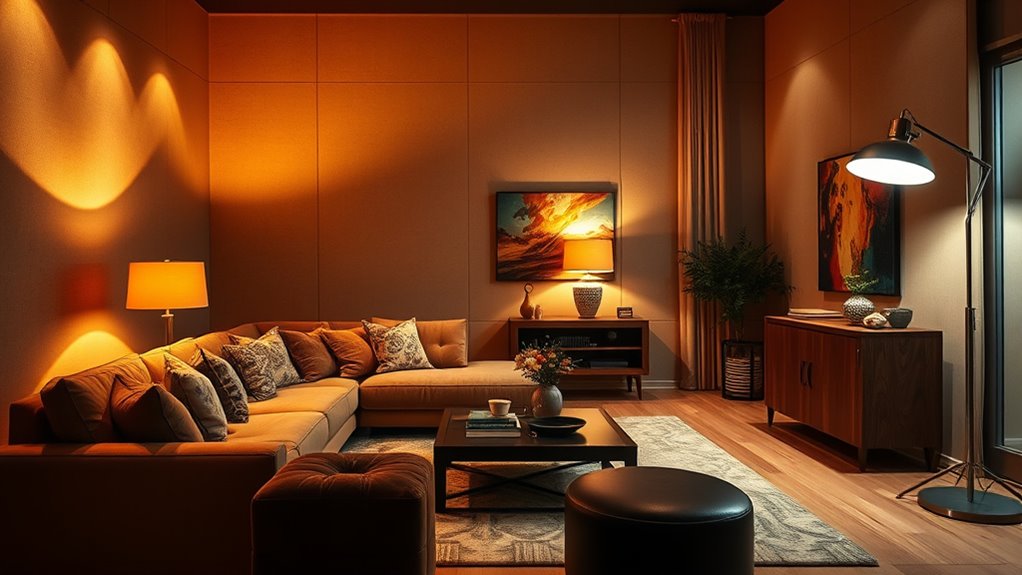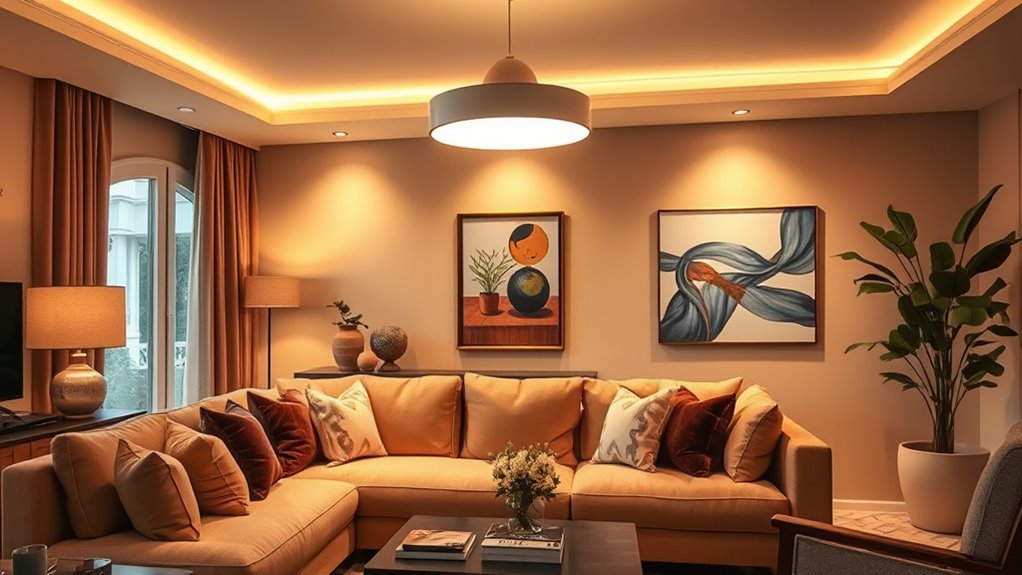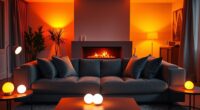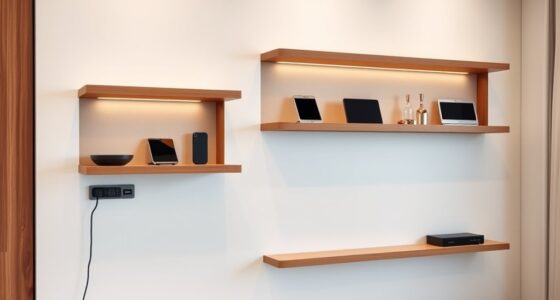To decorate with light temperature and CRI effectively, choose warm tones for cozy spaces like living rooms and bedrooms, and cool tones for functional areas like kitchens and workspaces. Prioritize high CRI bulbs to guarantee colors appear true, making your decor look vibrant and cohesive. Consistent lighting helps set the mood and highlight textures. Understanding these principles allows you to create inviting, polished environments—continue exploring to learn how to perfect your lighting choices.
Key Takeaways
- Match warm lighting (lower Kelvin) for cozy, relaxing spaces and cool lighting (higher Kelvin) for functional areas like kitchens.
- Choose high CRI bulbs to ensure accurate color rendering of furniture, walls, and decor.
- Use warm, high-CRI lighting to create inviting atmospheres, and cool, bright lighting to boost alertness and productivity.
- Select lighting based on room purpose to enhance mood, visual clarity, and aesthetic harmony.
- Understanding light temperature and CRI helps design personalized, well-balanced environments that support both style and function.

Have you ever wondered how different types of lighting can transform a room’s ambiance? It’s all about choosing the right light temperature and understanding the importance of CRI. When you select lighting that offers consistent color output, your space feels more cohesive and inviting. Color consistency is essential because it ensures that the colors of your furniture, walls, and decor appear true to life under the light. Without it, hues can look washed out, overly warm, or unnaturally cool, which disrupts the visual harmony you want to create. By paying attention to this, you can avoid mismatched tones and make your room look polished and well-thought-out.
Consistent color output makes your space feel cohesive and inviting.
Light temperature plays a significant role in setting the mood. For instance, warmer lights with lower Kelvin ratings create cozy, intimate atmospheres, perfect for living rooms or bedrooms where relaxation is key. Cooler temperatures, on the other hand, with higher Kelvin ratings, invoke alertness and clarity, ideal for kitchens, workspaces, or bathrooms. When you match the right light temperature to your room’s purpose, you enhance the overall mood and make your space more functional. This isn’t just about aesthetics—it’s about how the light influences your feelings and behavior. Soft, warm lighting can make a space feel more welcoming and comfortable, encouraging relaxation. Conversely, bright, cool lighting energizes and sharpens focus, helping you be more productive.
Mood enhancement goes beyond just the visual appeal; it’s about how lighting influences your emotional experience. When you use the right combination of color temperature and CRI, you can craft an environment that supports your activities and mood. Imagine reading under a warm, high-CRI light that accurately displays colors and textures—this makes your experience more enjoyable and less straining on your eyes. Or picture a workspace illuminated with crisp, cool light that boosts alertness and efficiency. The key lies in understanding that lighting isn’t just functional; it’s a powerful tool to shape how you feel in your space.
Ultimately, choosing lighting based on color consistency and mood enhancement helps you create a space that feels just right. It’s about more than illumination; it’s about designing an environment that supports your lifestyle and aesthetic preferences. When you understand the nuances of light temperature and CRI, you gain control over how your space looks and feels. This knowledge allows you to make smarter choices, ensuring your lighting complements your decor, enhances colors, and elevates the mood, making your home a true reflection of your personality and needs.
Frequently Asked Questions
How Does Light Temperature Affect Mood and Productivity?
You find that light temperature greatly influences your mood and productivity by shaping the lighting ambiance. Cooler light temperatures (around 5000K) promote alertness and focus, boosting your emotional response for work or study. Warmer tones (around 2700K) create a cozy, relaxing atmosphere, helping you unwind. Adjusting the light temperature according to your activities allows you to optimize your environment for both emotional well-being and efficient performance.
What Are the Best CRI Levels for Art Displays?
You should aim for a CRI of 90 or above when displaying art. High CRI guarantees accurate color matching and vibrant details, making your artwork look true to life. Use light layering, combining different light sources with varying intensities, to highlight textures and colors effectively. This approach enhances the viewing experience, ensuring that the art’s nuances are visible while maintaining consistent color rendering across your display.
Can Light Temperature Influence Sleep Patterns?
Light temperature can influence your sleep patterns by affecting your sleep cycles and melatonin production. Cooler, blue-rich light suppresses melatonin, making it harder to fall asleep, especially in the evening. Warmer light promotes melatonin release, helping you wind down naturally. To maintain healthy sleep, avoid bright, cool lighting before bed and opt for warmer tones in the evening. This way, you support your body’s natural sleep rhythm.
How Do Different CRI Ratings Impact Color Accuracy?
Higher CRI ratings improve color accuracy, meaning you’ll see true, vibrant colors under the light. For example, in a clothing store, a CRI of 90+ guarantees garments look natural, boosting customer confidence. Lower CRI lights can distort colors, reducing visual clarity. So, for spaces where accurate color representation matters, select lighting with a high CRI to enhance detail, true color rendering, and overall visual clarity.
Are There Energy-Efficient Lighting Options With High CRI?
Yes, you can find energy-efficient LED lighting options with high CRI. These LEDs deliver excellent color rendering while maintaining high efficiency, thanks to advanced technology that maximizes LED efficiency. Look for LEDs labeled with high CRI ratings (90+), which guarantee accurate color display without sacrificing energy savings. By choosing these, you get vibrant, true-to-life colors and lower energy bills, making them ideal for both aesthetic and sustainable lighting needs.
Conclusion
Now that you understand how light temperature and CRI shape your space, imagine what’s possible when you put this knowledge into action. Will you choose warm, inviting tones or crisp, energizing hues? The decision could transform your environment in ways you never expected. But here’s the catch—next time, there’s one more factor you must consider. Ready to discover what it is? Stay tuned, because your perfect lighting setup is just around the corner.









